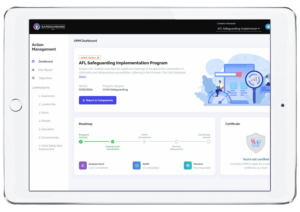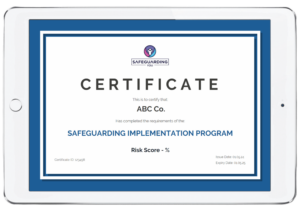Safeguarding Rugby League:
Tough on the Field, Safe Everywhere Else
Because safeguarding kids doesn't just happen.
Rugby League is a game built on grit, determination, and community spirit. At Safeguarding You, we understand the unique demands of Rugby League—and we’re here to help clubs and leagues provide a safe, inclusive, and supportive environment for everyone involved in the game.
Our tailored programs bring together Child Safety and Concussion Management into one streamlined solution. Designed in alignment with the NRL’s Safeguarding Standards and Head Injury Protocols, our programs ensure every club can meet its responsibilities and create a culture that prioritises player welfare.
Changing the Game of Safeguarding
Complete
Safeguarding
Online programs in a central, easy-to-use platform for clubs to manage compliance, risks, and wellbeing.
Tailored for
League Clubs
Designed with the unique challenges of league in mind, our programs align with NRL standards and guidelines.
Empowering
Clubs to Thrive
More than just tools - we allow clubs to focus on what they do best... fostering a love of the game.
Online + Realtime Programs
Safeguarding the Future of Rugby League
Rugby League is a sport built on trust and camaraderie, yet child safety risks – like inappropriate behaviour, inadequate policies, or a lack of supervision – can undermine these values. Without proper safeguards, young players may be left vulnerable in the very environment meant to nurture their growth and development.
When child safety isn’t prioritised, the consequences can be severe. Young players may experience harm, families lose confidence in the club, and organisations risk reputational damage, financial losses, and potential legal action. Without clear processes, even well-meaning clubs can inadvertently fail their duty of care.
Our child safety program provides Rugby League clubs with tools to align with NRL Safeguarding Standards. From establishing robust codes of conduct and delivering training to managing incidents effectively, we help clubs create safe, supportive environments for young athletes. By prioritising child safety, your club can build trust and ensure the game remains a positive experience for all.
Protecting Players’ Futures
In Rugby League, concussions are a constant risk due to the high-contact nature of the sport. Without proper prevention, diagnosis, and management protocols, players face serious immediate and long-term health risks, including brain injuries and diminished quality of life.
Failing to manage concussions effectively can have catastrophic effects – not just for the injured player but also for the club. Prolonged recovery, permanent injuries, and legal liabilities can arise if protocols aren’t followed. Clubs risk losing the trust of players and their families, as well as facing sanctions for non-compliance.
Our concussion management program equips Rugby League organisations with best-practice guidelines aligned with the Australian Institute of Sport and NRL Head Injury Protocols. We provide education for coaches, trainers, and administrators on recognising and managing concussions, along with structured return-to-play protocols. By implementing these measures, your club can safeguard player health and uphold its duty of care.
How It Works





Programs Include
-
Smart Self Assessment
-
Risk Report: High-Med-Low
-
Action Management Module
-
Incident Management
-
Digital Library of Resources
-
24/7 Realtime Access
Program Modules
Child Safety
Awareness is crucial in managing safeguarding responsibilities, particularly for organisations working with minors. It involves understanding legal obligations, recognising potential abuse signs, and knowing the correct responses. Such awareness ensures proactive protection of vulnerable individuals, creating a vigilant and responsible culture that minimises harm and promotes a safe environment.
Leadership plays a pivotal role in safeguarding, setting the tone for an organisation’s commitment to protecting vulnerable individuals. Effective leaders model best practices, establish clear policies, and foster an environment where safety is prioritised. Their proactive approach and dedication to creating a secure environment are essential for embedding safeguarding into the organisation’s culture, ensuring that protection measures are not only implemented but also continuously improved.
Rules are the backbone of safeguarding within any organisation, providing a clear framework for behavior and procedures that protect vulnerable individuals. They establish concrete guidelines and boundaries, ensuring everyone knows their responsibilities and the actions required to maintain a safe environment. Implementing and adhering to these rules is crucial for a systematic approach to prevention and response, creating a structured and secure setting for all participants.
People are at the heart of safeguarding efforts, embodying the principles and actions that protect the vulnerable. Their awareness, vigilance, and commitment to following established rules and guidelines bring safeguarding policies to life. By actively participating in training, reporting concerns, and fostering a culture of safety, individuals within an organisation ensure a protective and supportive environment, demonstrating that safeguarding is not just a policy but a collective responsibility.
Education is a critical component of safeguarding, empowering individuals with the knowledge and skills to identify, prevent, and respond to potential risks. Through ongoing training and awareness programs, everyone within an organisation becomes equipped to recognise signs of abuse or neglect and understand their role in the safeguarding process. This continuous learning environment not only strengthens the protective measures in place but also fosters a culture of vigilance and proactive care, ensuring the safety and well-being of vulnerable individuals.
Environments play a key role in safeguarding, requiring careful design and management to ensure they are safe and nurturing for all. By prioritising security measures, accessibility, and a culture of respect and inclusivity, organisations can create spaces that inherently minimise risks of harm. Effective environmental safeguarding involves regular risk assessments, clear signage, and protocols that everyone understands and follows, ensuring that the physical and emotional well-being of vulnerable individuals is protected.
Concussion
Club governance frameworks ensure that you prioritise player safety by implementing and enforcing rigorous concussion management policies. This includes the appointment of a dedicated Concussion Officer, regular training for all stakeholders, and the maintenance of detailed records to track compliance and ensure best practices are followed consistently.
On the day of injury, appropriate protocols ensure immediate and effective management of suspected concussions. This involves removing the player from play, conducting an initial assessment using standardised tools, and providing a quiet, safe environment for further evaluation, ensuring no player returns to the game until medically cleared.
Return to play protocols are designed to prioritise the health and recovery of players. These protocols require a step-by-step, individualised approach, ensuring players are symptom-free and have received medical clearance before resuming full contact activities, thus preventing premature returns and minimising the risk of further injury.
For players experiencing prolonged symptoms or multiple concussions, a robust management system in essential. This includes comprehensive medical evaluations, tailored recovery plans, and ongoing monitoring by healthcare professionals to ensure safe and effective recovery before returning to play.
Reduce the risk of concussion and head impacts by emphasising proper training techniques, enforcing the use of protective equipment, and staying up-to-date with rule changes that promote safer play. A proactive approach aims to minimise the frequency and severity of head injuries in players.
Utilise comprehensive diagnosis techniques to accurately assess and manage concussions. This includes the use of tools like the SCAT6, regular medical evaluations, and incorporating input from parents and teachers to ensure a holistic understanding of the player’s condition.
Recognising the unique needs of children and adolescents includes age-appropriate concussion management strategies. Ensure that young athletes are fully recovered and have returned to normal school activities before resuming sports, with continuous monitoring and communication between parents, teachers, and healthcare professionals.
Clear roles and responsibilities are defined to ensure effective implementation. From the Concussion Officer to coaches, medical staff, parents, and players, everyone has a specific role in recognising, managing, and preventing concussions, fostering a collaborative and supportive environment for player safety.
Optional Extras... Review & Certify
This Means: Order a Program Review & Receive a Certificate of Assessment


Safeguarding Survival Guide
Tailored for CSO’s, this guide cuts through the noise to deliver actionable strategies in Child Safeguarding.
More than just advice – it’s a blueprint for success. Avoid pitfalls, make smart decisions, and drive your organisation towards safer standards and sustainable growth. Don’t miss out on this opportunity to turn information into power.
The Child Safeguarding Survival Guide




